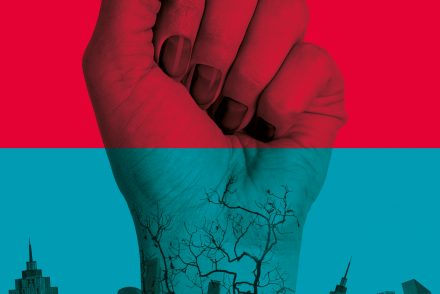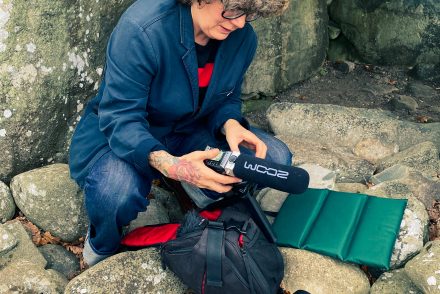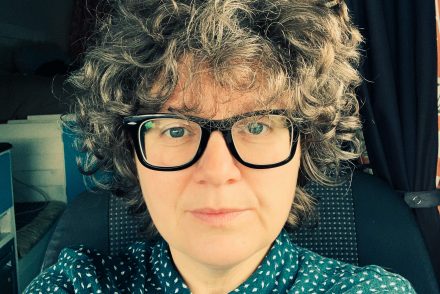Sophie McKeand
In response to a week-long creative residency at the National Trust’s Chirk Castle, Jan/Feb 2020
To ascend the steep, tree-lined, bird-song-filled lane and face Chirk Castle’s imposing portcullis entrance, is to do no less than to hike through centuries of time. Multifaceted layers hang like bright linen sheets in the morning fog of these borderlands, of y ffîn, so that if you slow down for long enough you might feel a slight caress on the cheek, or a brush against the shoulder as you sail through the hanes, the narrative, of this ancient cornerstone of our Cymraeg/English past.
Over the course of seven days, I was invited by the National Trust and Arts Council Wales to listen to the borderland and her story: to hear the words of staff and visitors, to immerse in the English and Cymraeg history, to re-walk (I’ve been here numerous times before) the land, and re-connect with the trees in (day)dreams.
Just days before leaving home, while preparing for this residency, I write a love poem:

The connection process with the land deepens from my current place in Portugal, and I understand that, as much as I have been asked to discuss borders, the land asks me to remember ecosystems, balance, inclusion, and the entire inter-species community continually evolving around the borderlands of north Wales.
I also note it is through poetry that she speaks.
In Wales, I stand at the original Offa’s Dyke in Y Gogledd Cymru (north Wales), and tumble into another time where this seemingly insignificant embankment would have dropped three meters into a sharp V shape (a legbreaker as it was known) with a two-meter-high mound aboveground constructed to defend against the native Cymraeg’s continual uprisings against the forces of Mercia (England).
A century later, Chirk Castle is built here by Roger Mortimer de Chirk as part of Edward I’s Iron Ring of castles across Y Gogs (north Wales) as the Welsh remain defiant in their determination for self-rule.
Three centuries later, the castle once again plays a part in the expansion of borders but this time as part of The British Empire when Sir Thomas Myddelton, who later becomes Lord Mayor of London, buys the property for £5000 and funnels much of his vast wealth here generated through entrepreneurial endeavours as one of the founders of the East India Trading Company and their colonisation of India.
The history of Chirk Castle is gnarly and tricksy. Conversations around it can feel as if they are fitted with trapdoors, or spiked walls; a spear is always lurking in a dark well of ignorance ready to gut the unaware (or less knowledgeable) speaker, so that a spell of silence feels as if it has fallen upon this magnificent castle, in a well-meaning attempt at keeping the peace.
But no silence lasts forever, just ask the trees.
Ask the thousand-year-old oak, our one living ancestor in this place who would have been witness to all of these historical events but whose roots are rotting, uncared for, in stagnant water at the Gates of the Dead (just off NT property), or, ask the five-hundred year-old oaks tended so carefully by the rangers; ask the thriving new woodlands planted by their hands each year; ask the non-native sequoia whose soft bark makes an impromptu overnight bothy for tree creepers – tiny birds who spiral ever upward in their hunt for food. This stunning redwood calls me, mid-residency, to remember we are here to heal, and that this cannot happen as a singular, individual endeavour, but needs to be a process that belongs to every blade of grass as much as every child who walks these rolling Cymraeg hills.

I walk and talk with visitors, staff, volunteers and a kaleidoscope of people who connect with the castle estate for multitudinous reasons aside from the obvious: Nordic walking, toddlers’ outdoor play, running, volunteers skill sharing, bird watching, and a returning theme echoes throughout these woods that the full history of this place could be shared with everyone:
Why isn’t it taught in schools? Is one question.
Another statement, This, is real political intrigue, real Game of Thrones stuff going on right here. I’d love for it to be more widely known.
It’s more interesting than fiction. Interjects his wife.
Hiking out on a bird walk with Kit from the RSPB, a cloud of redwing swarm into the trees above our heads in the chill mid-morning fug before settling down onto muted, tussocky January grasslands where we observe bursts of colourful red underwing and white flashes beneath sharpened eyes. These visitors will overwinter here before making their way across borders to Scandinavia for the summer. Upon each return, our avian migrants will be greeted with open arms, along with the swallows who take up residence in the castle over the warmer months, their presence no less important because they are not permanent residents.
A word I collect that day is N I C H E: Over time, every creature in nature evolves to fill their own specific niche. This beautiful thought sings to me just now as I feel that I too am evolving as an artist to find my own niche: a vanlife traveller who crosses European borders each year to return with new experiences, roosting for a time in my homeland of Cymru before migrating back to mainland Europe for the autumn/winter months.
This is the future I dream of. I visit and return, visit and return.

The border shifts like sanddunes in the mind as I try to grasp its significance to any other species except humans. Perhaps the dippers, in Cymraeg: Bronwen y dŵr
(Bronwen of the water) who inhabit the true border, the Ceiriog river, might know, but their stories are hidden in the unbroken Morse Code of their dip-dip-dipping.
Which makes me consider the borders around communications and languages that exist here, between Cymraeg and English, between connecting with trees, or listening to birds. Each offers a beautiful and unique way of engaging with the world, if we could only take time to learn, and listen, to offer each the equal importance it deserves.
Watching the children play in the mud, witnessing that visceral connection to the land and the dirt under their fingernails, is a joy. This is where the poetry lives. I also discover poetry in the words of the women running once a week through the woodlands who talk confidently of how vibrant and alive exercising here makes them feel. This is the language I am seeking.
And the word S Y N C R E T I S M is gifted by a young yew tree in the ornamental gardens: the amalgamation of religions, cultures or schools of thought; as well as the merging of different inflectional varieties of a word during the development of a language, and I can see this word flowing out across the landscape, pouring itself across the borders of language, time, species and culture, trickling from the mouths of future generations who will hopefully learn the full story of this landscape, not just of the people but our ancestors of branch and wing, of water and earth.
I return again to thoughts of time: to the fact that an oak tree can take three hundred years to grow, three hundred more to mature, and a final three hundred to die, and realise our concept of time has to dramatically change. What types of ancestor do we really want to be for the children who will live here in nine hundred years’ time? Thoughts also return to a giant 120-150-year-old fir tree whose future might be in doubt because it is considered ‘non-native’.
Which begs the question, how long does any living being have to be rooted in these borderlands to be able to call it home? My ancestors first settled here around the same time as this fir seed landed – are we ‘non-native’ too? The borders around language are vague in places, yet sharply defined in others: rabbits have existed here long enough to now be called a ‘naturalised’ species, existing here for so long they have become part of the natural food chain, they have integrated into the ecosystem.

Perhaps these borders only exist in time? Once a species crosses a certain border in time their status changes from non-native, to naturalised, to native? This is how the ecosystem balances. If only we could trust her more. If only we could let go control and allow her to work her magic.
Is this the same with languages?
There are fourteen indigenous languages spoken across these British Isles, all of which make up the rich and vibrant tapestry of our daily lives, as well as languages such as Polish and Chinese that have crossed so many borders in the mouths of people to reach our shores and enrich our lives.
This border is a P O R O U S one, with time and people, languages and creatures spilling across in constant flux, so perhaps the most obvious static border is the one that exist between people and the natural world. The myriad ways in which our species dominates every landscape: there is no hill or tree on this estate that has not been touched by human hand in one way or another, and yet head ranger Carl notes how this boundary only every feels as if it is crossed in one direction, with humanity constantly infringing on nature, giving little concern in return.

Perhaps the antidote to this lies in the beautiful and constant work of the estate’s rangers and volunteers and I’d love to see Land Champions appointed, people who would give voice to the land and her inhabitants at board meetings and National Trust conferences where the future of these places is decided. The only remit of these Land Champions would be to say what is best for the natural world, without having to take into account the wishes or demands of humanity.
To give voice to the voiceless is a noble thing to do.
On my last afternoon in this magical place, I sit in a rainstorm with creative producer and Cymraeg speaker, Lisa Heledd-Jones, as we listen to the borderland through the medium of field recordings. With contact mics wired up to the fenceposts I am transported to an otherworldly place as the water cascades against the wire fence creating ethereal sounds that are indiscernible without the mics to my human ears, and I’m reminded of a passage from my favourite book on trees, Peter Wohlleben’s The Hidden Life of Trees, and a discovery that perhaps tree roots communicate through sound, which is something we do too; and his thoughts that perhaps we’re not so different after all.
I leave Chirk Castle with the voices of the trees ringing in my ears, the sounds of these utterly sublime borderlands echoing in my heart, and the knowledge that this liminal space, this ever-evolving interspecies ecosystem is so much greater that a borderline on a map. It is home to endless conflicts and contradictions that have carved out a unique place in time, and it is also home (either permanent or fleeting) for an orchestra of animals and people.
All of these diverse elements comprising this beautiful place deserve to be cherished in the way that nature’s ecosystems shift constantly to accommodate all beings. Perhaps we can emulate her for a change, by relinquishing some control, by being more accepting, of ourselves, and our history, by learning to support every narrative in a way that allows for each story to unfold out into the world in its most true and honest expression.
The series of Instagram Stories documenting this residency can be found on my @sophiemckeand_outsider page here.










No Comments